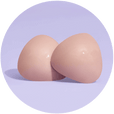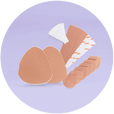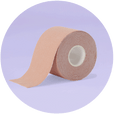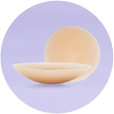There's a magical game-changer in the world of fashion for those blessed with big boobs: boob tape. This product will soon become your wardrobe's secret weapon, designed to provide lift and support.
Boob tape allows you to rock any outfit with confidence, whether it features a plunging neckline, no straps, or a low-cut back. Within minutes, you can use it to create a shapely, defined look without any visible support.
Let's explore how boob tape works this magic for large-busted ladies, including everything you need to know for flawless application and safe removal.
Benefits of Boob Taping for Larger Busts
Boob taping for larger busts relies on supportive taping techniques using adhesive tape to lift, secure, and shape your breasts, enhancing your cleavage and silhouette. The tape typically functions like a bra but offers invisible support, letting you wear many different fashion styles, such as backless dresses, plunging necklines, strapless styles, etc.
While some people use various tapes on their breasts, choosing a boob tape specific for this purpose is a safer choice, as other types of tape could result in adverse outcomes, such as skin burns.

How to Tape Big Boobs
This section will guide you through the process of taping your bust. Follow these essential steps to ensure a safe and practical application.
Perform a Patch Test: Apply a small strip of tape on your boob or chest skin and remove it up to 8 hours later (or immediately if you experience symptoms). Watch for any signs of irritation over 24 hours. If no irritation occurs, you can proceed with taping your bust.
Prep Your Skin: Ensure your skin is clean, dry, and free of oils, creams, or lotions that can interfere with the tape's adhesive properties and lead to slippage.
Gather the Necessary Supplies: Gather your chosen boob tape, scissors, and nipple covers for added protection in sensitive areas. Ensure you're using sweat-resistant boob tape for those hotter days or active events.
Cut the Tape into Strips: Measure how much tape you will need and then cut your strips of boob tape, customizing the length of these for your own personal needs.
Place the Nipple Covers: This will protect your sensitive areas underneath the boob tape, which can have a solid adhesive.
Apply the Boob Tape: To prevent visibility under clothing, apply the tape while you're standing or seated upright to ensure the correct positioning.
- For Strapless Dresses: Tape across your boobs, placing the tape strips on the outer side of your bust and pulling the tape across to the other outer side.
- For Deep-Plunge Dresses: For a neckline that plunges below your boobs, tape each breast separately, extending long strips from underneath your breast and over it, attaching the other end near your collarbone for a lifted appearance that makes your boobs look perky.
- For Halter-Neck Dresses: If your dress has a wide halter neck, apply tape at the bottom of your breasts and pull upward, attaching it to your neck and providing lift and support. If your dress has a narrow halter, tape your boobs as though for a strapless dress.
- For Low-Back Dresses: Start taping from the outer undersides of your breasts and pull upward, giving a natural lift and pull. Whether you pull the tape inward depends on your dress's neckline and whether or not you want cleavage.
Adjust the Tape: Tailor the application to your selected dress to ensure the tape remains concealed while enhancing your shape and supporting you. Walk around a little to ensure the application is comfortable, and check for any areas where you might need to trim the tape to keep it invisible under your outfit.
Rock Your Outfit: Even if you have a big bust, the boob tape will keep your breasts secure. You should always feel supported and comfortable while wearing the tape, no matter which outfit you choose to wear.

Boob Tape Mistakes to Avoid
- Not Pulling the Tape Taut: Apply the tape with enough firmness to brace and lift your breasts but try not to restrict or compress them completely. Ensure the tape adequately adheres to your skin without slippage by pressing it against it.
- Not Practicing Proper Skin Care After Removal: Care for your skin by taking your time removing the boob tape. After removal, clean and moisturize your skin to help it recover. Ideally, avoid taping your boobs again and steer clear of tight clothing for a few days to allow your skin to breathe and your breasts to recover further.
Aftercare & Tape Removal
Use oil like coconut or baby oil to break down the adhesive for safe removal. Apply the oil generously around the edges of the tape and wait a few minutes before slowly and gently peeling off the tape to avoid skin irritation.
Gently clean the area using lukewarm water and mild soap, then pat your skin dry. Apply aloe vera gel or a hydrating moisturizer to soothe your skin and replenish its moisture.
Frequently Asked Questions
Does boob tape work for larger breasts?
Yes, boob tape works effectively across different breast sizes. For example, Nueboo Boob Tape is compatible with cup sizes A-G (DDDD). For larger breasts, the amount of tape you need to use may be more than a person might use for smaller breasts.
Should I perform a test patch while using boob tape?
Absolutely. It's recommended to do a patch test before using the boob tape. Apply a small section of tape on your chest for up to 8 hours. You can use the product if you don't experience irritation while wearing the tape.
How can I use boob tape for deep-plunge dresses?
For deep-plunge dresses, apply a few vertical strips of tape upwards from the bottom of your breast to your collarbone. These strips should align with the shape of your dress and create a triangle shape for support.
How should I use boob tape for strapless dresses?
Use tape strips that don't extend as high on the chest for strapless dresses. Apply horizontal strips across your chest for support and lift without a bra.






0 comments